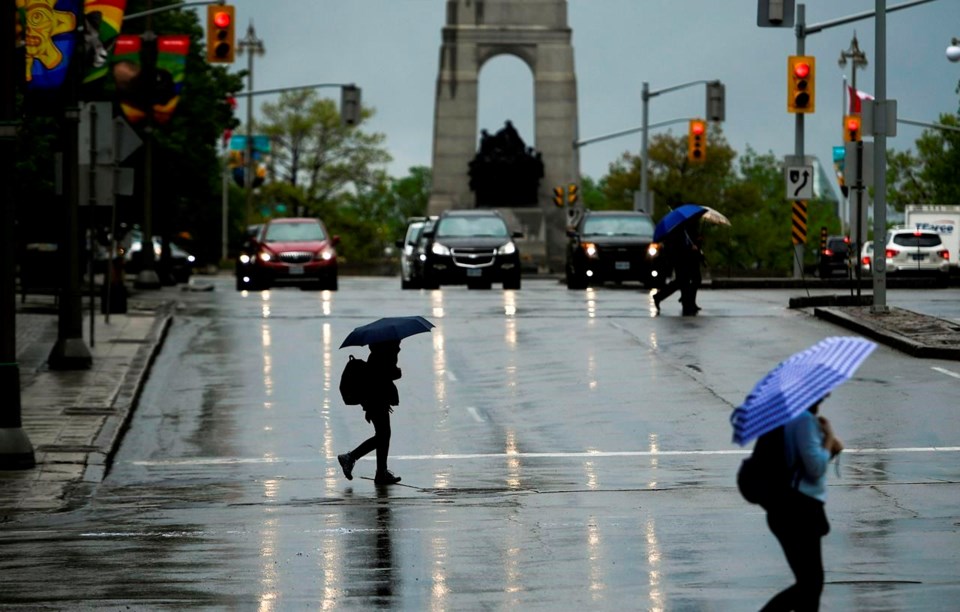OTTAWA — Mother Nature delivered a typical spring day Wednesday in Ottawa, with a morning of light drizzle fading into afternoon sunshine, near-freezing temperatures — and thousands of grams of plastic.
That "plastic forecast" comes from a project of Australia's Minderoo Foundation, trying to draw attention to the scope of the world's plastic problem as negotiations for a global treaty to end plastic waste continue in the national capital.
"We've produced so much plastic it's now in our weather," the foundation's report said.
The data is based on scientific measurements of microplastics in the air in Ottawa that were gathered by Minderoo scientists in February and March.Â
They also measured the amount of plastic in Ottawa's drinking water, finding that on any given day someone consuming the recommended 2.5 litres of water would also ingest about 5,400 nanoparticles of plastic.
Microscopic bits of plastic can be described as "microplastics" — no bigger than the eraser on the end of a pencil — or nanoparticles, which are smaller than one-millionth of a millimetre.
"Thousands of tonnes of microplastics are falling on Ottawa, falling on other cities around the world," said Minderoo founder Andrew Forrest. "It's falling on your food, it's falling into the air you breathe, the water you drink.
"I think it's really serious and the fact that it's raining down on us, essentially, because it's everywhere."
To drive the point home, Minderoo is displaying its daily plastic forecast around the city, including on digital billboards at the Ottawa airport.
Medical research has linked plastics to a myriad of health conditions, including infertility, a higher rate of miscarriage and some cancers. The research is still very premature, in part because the plastics problem is a relatively new phenomenon.
More than half of all the plastics ever made in the world have been produced in just the last 20 years.
The Organization for Economic Co-operation and Development says global plastic production grew from 234 million tonnes in 2000 to 460 million tonnes in 2019, while plastic waste grew from 156 million tonnes to 353 million tonnes.
About one-fifth of that waste ended up in the environment, while less than one-tenth was recycled.
Statistics Canada, which recently updated its plastics data reporting to aid the national zero-plastic waste strategy, reports that nationally, plastic production and imports grew from 5.6 million tonnes in 2012 to almost 7.1 million tonnes in 2019, and slightly more than 7.1 million tonnes in 2020.
In 2012, Canadians threw away about 4.3 million tonnes of plastic, and in 2020 that had grown to 4.9 million tonnes. Forty per cent of all plastic waste in Canada comes from packaging.
Plastic particles get into the environment in multiple ways, sometimes on purpose as litter, or from unmanaged trash heaps. Sometimes it's from managed landfills where plastic slowly breaks down, leaches into the soil or is washed into waterways.
Some start out small — microbeads for example, or glitter, which is really just tiny plastic pieces coated in aluminum. Others start out big and become smaller over time.
"Every plastic bottle or bag or straw that we leave out in the environment eventually will break up into thousands and thousands of microplastics," said Anja Brandon, associate director of U.S. plastics policy at Ocean Conservancy.
Once those plastics leach into the soil and water and air, they become part of the food chain. Plastics have been found in all parts of plants, including the roots, stems, petals and fruit.Â
A study released in January led by researchers at Ocean Conservancy and the University of Toronto found microplastics in 16 different proteins, including fish, seafood, beef, pork, chicken, plant-based fish sticks and ground beef.
A 2021 study published in the journal Science Direct found evidence of plastic particles in apples, pears, carrots, lettuce, broccoli and potatoes.
Brandon said plastic microfibres are a mainstay of the fashion industry and every time a load of laundry gets run through a washing machine it can flush 18 million microfibres of plastic down the drain.
Once these particles get added to the environment, they're impossible to totally remove, said Brandon. She likened it to taking a beach worth of sand and sprinkling it around a lake and asking someone to recover every single grain.
"You're never going to get them all."
Brandon said because plastics exposure is still relatively new, there is no long-term evidence about what will happen to people from the repeated and constant exposures.
Brandon said the main solution to the problem is to reduce how much plastic we're releasing into the environment and the only way to do that, she said, is to make less of it.
"If we want to tackle the plastic crisis for the sake of our ocean communities, public health, human health, all of it, we need to start with reductions to make and use less single use plastic in the first place," she said.
"We need to better manage the plastics we are going to use, so that means redesigning those plastics such that they can actually be reused or recycled and stay in the economy."
The plastic treaty negotiations are looking at all sorts of solutions, including whether to put strict caps on how much plastic is made and ban the most toxic chemicals used to make plastic.
This report by The Canadian Press was first published April 24, 2024.
Mia Rabson, The Canadian Press




